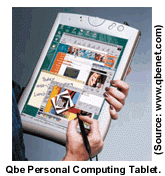|
Inventor's 20/20 foresight
|
 |
February 27, 2001: 7:43 a.m. ET
Six years to success: You've got vision, but do you have the gumption to use it?
By Don Debelak
|
NEW YORK (Entrepreneur.com) - In 1993, Jon-Erik Prichard was working as the creative director for an ad agency that worked with telecommunications companies. One of the main thrusts in the industry at the time was wireless communications.
Then one day, "It all just came to me," says Prichard, 38. He realized combining wireless technology with speech and handwriting recognition software would result in a truly mobile computer with user-friendly communications features. People could use this computer any time, anywhere without bothering to hook up to a modem or a networking cable, even forfeiting the need for a keyboard or a mouse.
In November 1999, Prichard introduced his Qbe Personal Computing Tablet, a product that Prichard says his company, Aqcess Technologies Inc., "can't make fast enough to meet demand." The company is now shipping 5,000 units per month.
 At 14-by-10-by-1.6 inches, the Qbe is sleek, snappy and just slightly larger than a tablet of paper. The entire device is a full-size screen that has speech and handwriting software, a stylus for moving the cursor (or writing) on-screen and even a digital camera with videoconferencing and still-photo capabilities. It requires no keyboard, no wires and no mouse (though all three are available for people wanting to work at a desk in a traditional office setting). At 14-by-10-by-1.6 inches, the Qbe is sleek, snappy and just slightly larger than a tablet of paper. The entire device is a full-size screen that has speech and handwriting software, a stylus for moving the cursor (or writing) on-screen and even a digital camera with videoconferencing and still-photo capabilities. It requires no keyboard, no wires and no mouse (though all three are available for people wanting to work at a desk in a traditional office setting).
Prichard began by selling a business version that was in the $4,000 range. The market responding fastest to the Qbe has been real estate, where employees are always on the road and frequently need to convey visual images to customers.
A consumer version at a lower cost is expected to be released late this year and will be priced under $2,000. This new device will allow consumers to do everything from read a downloaded book in bed to comparison shop on the Net while browsing at the mall.
Of course, most of us can see the benefits of the Qbe immediately, which is why the product appears to be a runaway success in today's market. But to get the product out in 2000, Prichard had to commit to the idea in 1995...before the Internet was popular, before Palm Pilots were on the market, even before the first effective speech and handwriting software had been developed.
Almost everyone thought he was insane. In fact, most people didn't believe many of the future technologies Prichard was counting on would ever exist. But Prichard made that transition from potential kook to bona fide genius by being right on target with his big vision.
Six years to success
Though he struggled for six years against seemingly impossible odds, Prichard believed in his ideas and never doubted that his product would be perfect for the market once it was ready. Here is a breakdown of the trials and tribulations he endured and the way his vision "saved" him:
Year One. "I financed this entire year from my savings," Prichard says. "At the end of the year I had some cardboard models and a plan." He also had some foretelling stories about future technology. "I talked to a lot of people and most couldn't see my vision at all. But every now and then I found someone who understood my vision and believed in me."
Year Two. "I received some financing but was still working without a salary," Prichard says. It was a tough year, with Prichard running low on resources but nonetheless managing to put together some working models and demonstrate his vision.
Years Three and Four. Prichard spent these years further developing the product, deciding what markets to focus on and setting up a plan for launching the product. He finally raised enough money to start taking a salary.
Years Five and Six. Prichard started to pre-sell his product through press releases, attending trade shows and via his connection with Ingram-Micro and Tech Data, distributors for his vertical markets. In addition, Prichard worked to finalize production details and lined up financing to produce his initial production run and launch the Qbe.
Year Seven. With the Qbe well-established, Prichard turned his attention toward the consumer marketplace. He created a smaller, lighter version of the Qbe designed specifically for everyday use. This competitively priced model will be made available in October. Furthermore, Aqcess recently reduced the price of its Qbe Cirrus model to $2,999.
Go big or go home
I've worked with new products for more than 20 years, and the one thing people perpetually ask me is how I can tell when a product will succeed. The answer is simply that I can't. Nobody can. Because for every idea, no matter how great it is, success ends up depending on the grit and determination of the inventor.
 Prichard started out with only a firm belief in his idea. The road to success clearly has hundreds of red lights; only a precious few green ones offer any hope that an idea might succeed. But the odds didn't matter to Prichard; he only considered his dream. Prichard started out with only a firm belief in his idea. The road to success clearly has hundreds of red lights; only a precious few green ones offer any hope that an idea might succeed. But the odds didn't matter to Prichard; he only considered his dream.
Are you searching for someone to take your idea to the market? Take a look in the mirror. You may, of course, get people to help you, but when all is said and done, it's the inventor who has to go out into the often inhospitable world and make success happen. The best way to make your fortune is to have more than just a run-of-the-mill idea. You need to have an idea with a big vision. Believe me, investors and buyers will take notice.
Q & A
Don Debelak: Did you ever feel like giving up?
Jon-Erik Prichard: No. I always believed I could make it. That doesn't mean I didn't get mighty discouraged.
Debelak: When you started, you had to foresee it would take you five to six years to launch the product. What made you decide to go ahead?
Prichard: I'm an entrepreneur, a risk-taker, and I felt the product would succeed.
Debelak: How did you choose your initial target markets?
Prichard: I was looking for vertical markets that had a strong need for a mobile communications device that would be easy to sell to. These markets included real estate, insurance, claims adjusting and medical records.
Foreign affairs
U.S. patent only protects your product in the United States. If you want to protect your product worldwide, you can file a Patent Cooperation Treaty (PCT) application, which protects you in most major markets. The cost of a PCT patent application is $1,900.
That sounds like a fair proposal, but Al Davis, a retired patent agent and long-time patent examiner, points out several problems inventors should be aware of before filing for a PCT:
Because it is a requirement that an attorney rewrite a U.S. application into PCT form, a PCT patent will cost you around $1,600 in attorney fees.
| |

|
|
| |
|
|
| |
I always believed I could make it. That doesn't mean I didn't get mighty discouraged
|
|
| |
|
|
| |

|
|
| |
|
|
| |
Jon-Erik Prichard |
|
You'll spend thousands of dollars annually to maintain your patent in each country it's filed in. Most countries require maintenance fees every year, vs. every 3.5 years in the United States. Total maintenance fees are more than $100,000 over the life of a patent.
The violators of your patent rights in overseas markets are more expensive to find.
The courts that enforce overseas patents may favor their own citizens and companies over foreign inventors.
Final analysis: The PCT application may be great for big companies with huge amounts of money, but still isn't a viable option for most inventors.
TV Guide Inventors Insider is a weekly on-demand Internet TV program that covers the entire invention process but concentrates on the patent process.
The show's host, veteran patent attorney Randy Notzen, interviews industry insiders and legal experts about a variety of issues affecting inventors, including patent legislation, product agents, trade shows, intellectual property and the effect of the Internet on the invention process. 
|
|
|
|
|
 |

|

